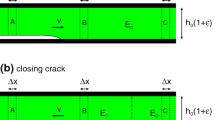Abstract
The theories describing self-oscillating neck propagation in polymers are compared with the experimental data. For the description of self-oscillating neck propagation in PET, the system of equations is proposed. This theory is based on the Toda equation for the thermal conductivity in the incoming flow, which takes into account heat release into the environment. Numerical solution demonstrates the existence of self-excited oscillations in the ascending branch of the strain rate dependence of postyield stress, and this result conflicts with the Davidenkov criterion but fully agrees with the experimental evidence. The Barenblatt model takes into account the limited compliance of the samples and provides further development of the Davidenkov model. Self-oscillating neck propagation in polymers is shown to be qualitatively different from relaxation oscillations (for example, periodic slippage of a load along a table) and from oscillations described by the first-order kinetic equations. Hence, the instability of the systems described by the equation of thermal conductivity and the system of kinetic equations appears to be principally different.
Similar content being viewed by others
References
A. Portevin and F. LeChatelier, Trans. Am. Soc. Steel Treat. 5, 457 (1924).
D. C. Hookway, J. Text. Inst. 49, 292 (1958).
W. Roth and R. Schroth, Faserforsch. Textiltech. 11, 312 (1960).
A. S. Kechek’yan, G. P. Andrianova, and V. A. Kargin, Vysokomol. Soedin., Ser. A 12, 2424 (1970).
G. P. Andrianova, Yu. P. Popov, and B. A. Arutyunov, Vysokomol. Soedin., Ser. A 18, 2311 (1976).
Y. K. Godovsky, Thermophysical Properties of Polymers (Springer, Berlin, 1993), p. 227.
S. L. Bazhenov, Yu. A. Rodionova, A. S. Kechek’yan, and A. K. Rogozinskii, Polymer Science, Ser. A 47, 692 (2005) [Vysokomol. Soedin., Ser. A 47, 1131 (2005)].
V. A. Mikhel’son, Collected Works (Novyi Agronom, Moscow, 1930) [in Russian].
Ya. B. Zel’dovich, G. I. Barenblatt, V. B. Librovich, and G. M. Makhviladze, Mathematical Theory of Combustion and Explosion (Nauka, Moscow, 1980).
N. N. Davidenkov, Fiz. Tverd. Tela (Leningrad) 3, 2458 (1961).
G. I. Barenblatt, Mekh. Tverd. Tela, No. 5, 121 (1970).
A. A. Andronov, A. A. Vitt, and S. E. Khaikin, Theory of Vibrations (Nauka, Moscow, 1981) [in Russian].
S. L. Bazhenov and A. S. Kechek’yan, Polymer Science, Ser. A 43, 52 (2001) [Vysokomol. Soedin., Ser. A 43, 63 (2001)].
S. L. Bazhenov and A. S. Kechek’yan, Polymer Science, Ser. A 44, 386 (2002) [Vysokomol. Soedin., Ser. A 44, 629 (2002)].
J. Karger-Kocsis, O. I. Benevolenski, and E. J. Moskala, J. Mater. Sci. 36, 3365 (2001).
A. Toda, Polymer 35, 3638 (1994).
Author information
Authors and Affiliations
Corresponding author
Additional information
Original Russian Text © S.L. Bazhenov, E.P. Koval’chuk, 2008, published in Vysokomolekulyarnye Soedineniya, Ser. A, 2008, Vol. 50, No. 3, pp. 501–509.
This work was supported by the Russian Foundation for Basic Research, project no. 04-03-32764.
Rights and permissions
About this article
Cite this article
Bazhenov, S.L., Koval’chuk, E.P. Theory of self-oscillating neck propagation in polymers. Polym. Sci. Ser. A 50, 328–334 (2008). https://doi.org/10.1134/S0965545X08030115
Received:
Accepted:
Published:
Issue Date:
DOI: https://doi.org/10.1134/S0965545X08030115




